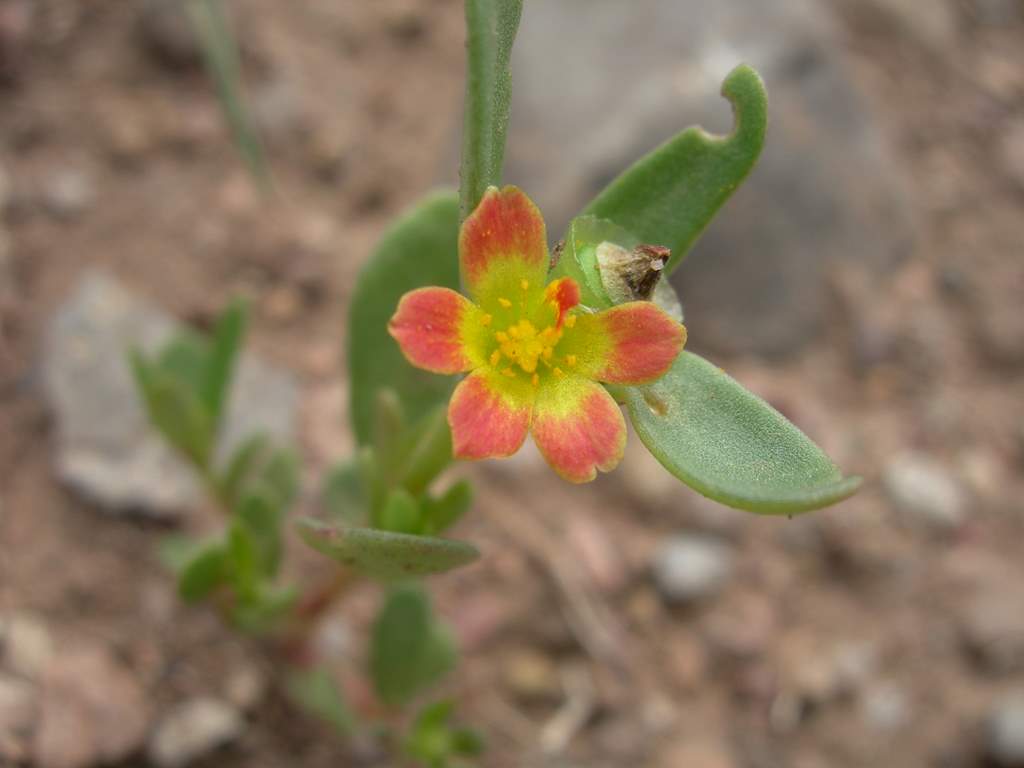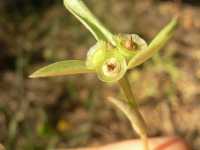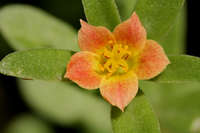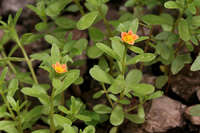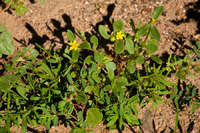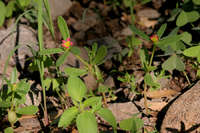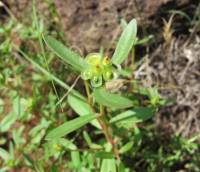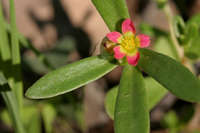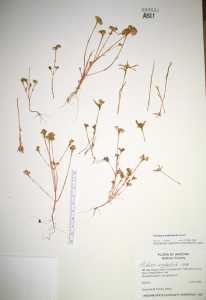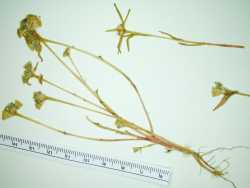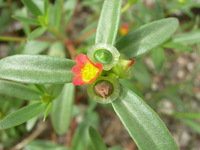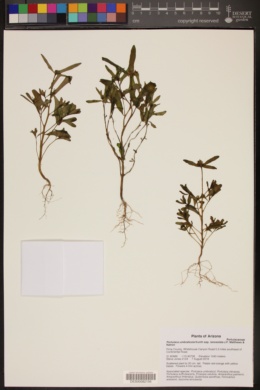|
|
|
|
Family: Portulacaceae
wingpod purslane
|
Plants annual; roots fibrous. Stems prostrate to suberect; trichomes sparse at nodes and in inflorescence, stems otherwise glabrous; branches 5-20 cm. Leaf blades obovate, spatulate, or sometimes lan-ceolate, flattened, 10-35 × 2-15 mm, apex rounded to truncate; involucrelike leaves 4-5. Flowers 8-15 mm diam.; petals yellow or yellow tipped with red or copper, spatulate or obovate, 5-10 × 3-6 mm, apex acute or cuspidate; stamens 7-30; stigmas (3-)5-18. Capsules obovoid or turbinate, 3-5 mm diam., with encircling, expanded, membranaceous wing 0.5-1.5 mm wide proximal to suture. Seeds gray, round or elongate, flattened, 0.5-1 mm; surface cells stellate with long tubercles. Portulaca umbraticola is a common weedy species of the southwestern United States, while in the southeastern United States it is usually restricted to sandy soils of granitic and sandstone outcrops. In 1982-1983, a new cultivar was introduced to the United States in hanging baskets, under the name Portulaca umbraticola `Wildfire Mixed,´ which appears to be selected from material from South America. There is no seed surface variability in any of the three subspecies.
PLANT: Annual herbs with a fibrous root. STEMS: prostrate to erect or ascending, 4-20 cm long, glabrous. LEAVES: few, mostly alternate, sometimes subopposite, flat, lanceolate or spatulate, 10-35 mm long, 2-15 mm wide, glabrous; nodes sometimes with a few inconspicuous hairs. INFLORESCENCE: glabrous, with 4-5 conspicuous involucral leaves, 10-30 mm long, 1-7 mm wide. FLOWERS: clustered at the ends of branches; petals pink, purple, yellow or orange tipped with red, 5-10 mm long; stigmatic branches 5-18. CAPSULE: 3-5 mm in diameter with an expanded circular membranaceous wing just below the rim; stipe 1-1.5 mm long. SEEDS: gray, tuberculate NOTES: AZ to NC, s to TX; S. Amer. -- Subsp. lanceolata J.F. Matthews & Ketron. (lance-shaped [leaves]). —Flower diameter 8-15 mm; petals bi-colored. [P. lanceolata J.F. Matthews & Ketron]. —Dry sandy or rockysoils, desert grasslands, oak woodlands, wash bottoms, disturbed sites: Cochise, Gila, Graham, Pima, Santa Cruz cos.; 900-1850 m (3000-6000 ft). Jun-Oct. NM e to AR, LA. REFERENCES: Allison Bair, Marissa Howe, Daniela Roth, Robin Taylor, Tina Ayers, and Robert W. Kiger., 2006, Vascular Plants of Arizona: Portulacaceae. CANOTIA 2(1): 1-22. Bair et al. 2006, FNA 2003 Duration: Annual Nativity: Native Lifeform: Forb/Herb General: Annual with fibrous roots, stems erect or ascending 10-23 cm, stems glabrous, with sparse hairs at nodes. Leaves: Mostly alternate, sometimes subopposite, few, flat, lanceolate or spatulate, 10-35 mm long, 2-15 mm wide, glabrous. Flowers: Glabrous with 4-5 conspicuous involucral leaves, 10-30 mm long, 1-7 mm wide; flowers clustered at ends of branches; petals pink, purple, yellow or orange tipped with red, 5-10 mm long, stigmatic branches 5-18. Fruits: Capsule 3-5 mm in diameter with expanded circular membranous wing just below rim. Ecology: Found in sandy or rocky soils, along washes and disturbed sites from 3,000-6,000 ft (914-1829 m); flowers June-October. Distribution: AZ, s NM, s OK, TX, east to NC; south to S MEX and in S. Amer. Notes: Portulacas in the region are small herbs with succulent leaves and stems, can have colorful flowers and possess capsules with few-many subtending leaves. P. umbraticola is distinct with its lanceolate-spatulate leaves and especially the membranous ring around the capsule. Ours are generally subsp. lanceolata, which is distinguished by the 8-15 mm flower diameter with the bi-colored flowers. Ethnobotany: Many species in the genus are edible and used as potherbs. Etymology: Portulaca means -milk-carrier,- but it comes from the Latin for small gate or door, from the capsule lid, while umbraticola comes form Latin umbraculum, for shady place. Synonyms: None Editor: SBuckley 2010, FSCoburn 2015 |
|
|
|


